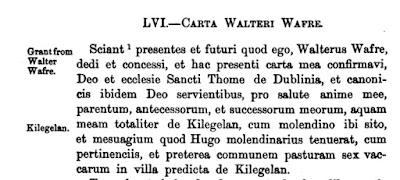Many years ago, when I first began to map my DNA chromosome matches I was surprised to find, on my maternal side, a very large segment on chromosome 10 with many matches at the 16 to 44cM size. Twenty of these matches have as their ancestor one of four of the sons (John, Joseph, William and Jacob) of Abraham Woertman (b.1709) and Anna Smith (b.1706). Abraham Woertman and Anna Smith were from early New Jersey and deeply connected with the Dutch families who had come there from New York. Abraham was baptized in 1709 in the Dutch Reformed Church of Raritan (Somerville), New Jersey. Abraham and Anna's children are purported to have been born in New Jersey. I have only one birth or baptismal record for any of their children - Andries (Andrew) baptized in 1741 in the Dutch Reformed Church of Readington, Somerset County, New Jersey. From military records I know that Joseph Woertman was born about 1758 in New Jersey. He died in Tazewell, Virginia. Most of the sons began using Workman in place of Woertman - and, it appears, that Workman was the correct surname for this line in England prior to their relocating to the Netherlands.
So, it is obvious from my many matches on the chromosome 10 segment that I, somehow, have Abraham Woertman and Anna Smith as direct ancestors - but how? Who is the missing link between this couple and my known maternal ancestors?
I am not at all surprised by these DNA findings with so many of my mother's ancestors coming from early New Jersey and many being connected to the early Dutch families there. Yet, the missing link mystery needs to be solved
The first step was to try and isolate which ancestral line this match was coming from and I did that through the matches on this chromosome 10 line using chromosome mapping and also comparing verified matches on my mother's line to those in the Woertman matches. Over the years, as I accumulated more matches, I was able to determine that the Abraham Woertman and Anna Smith DNA was coming from my Covert line of New Jersey and Pennsylvania. My earliest verifiable Covert ancestor is Tunis Covert who fought in the Revolutionary War for its duration with the New Jersey 1st Regiment. According to his headstone in Wilkes-Barre, Pennsylvania, he was born in 1748 and died 1811.
Despite years of research, I never found a record for the parents of my Tunis Covert. However, I have accumulated many records showing his military career, his marriage, and his residences in Pennsylvania. Early DNA matches proved my theory of which of his sons I descend from. Because this large mystery DNA match is with four of the sons of Abraham Woertman and Anna Smith, I know that the link to my Covert line is through one of this couple's children. I investigated other matches on this segment and found a family that descends from Morris Covert - a probable son of Abraham Covert and Hannah Workman - both from New Jersey.
Though a Hannah Workman seems to be common knowledge as this Abraham Covert's wife, no record has been found to support this. I researched this line, and based upon birth years of their sons and locations, I reached the conclusion that it is highly likely Abraham Covert and Hannah Workman are the parents of my Tunis Covert born 1748. This theory is based upon the real possibility that Hannah Workman was the daughter of Abraham Woertman and Anna Smith and explains why I have so many matches on chromosome 10 to her brothers.
Here are the points I used to come to this conclusion:
* There is a long-standing familial relationship between the Woertman and Covert families in New York and New Jersey. Abraham Covert's paternal uncle was Lucas Covert baptized in 1699 on Long Island who married the sister of Abraham Woertman - my DNA proven ancestor born 1709.
* Abraham Covert (b. circa 1729) and Hannah Workman had these sons attributed to them: Isaac b. 1745, Abraham b. 1748, John b. 1750, and Morris b. 1754. My Tunis Covert was born 1748.
* Isaac, Morris and John Covert enlisted from Northampton, Pennsylvania during the Revolutionary War. John Covert was enlisted by 1780 in the 6th Company Associators & Militia for Northampton Co, Pennsylvania militia with rank of Sergeant serving under Capt. Patrick Campbell. Morris and Issac Covert also appeared in this company with John by 1782.
* In 1790 (after discharge in 1783) Tunis "Anthony" Covert was living with his wife and two eldest sons in Lower Smithfield, Northampton County, Pennsylvania. Also in Northampton County 1785 were Isaac Covert (Mt. Bethel Twp. also in 1786) and John Covert (Turbot Twp. also there in 1786/87). In 1788 Isaac was living in Lower Mt. Bethel Twp. also in 1790). Coincidence or family connections?
* Tunis Covert named his first son John. Did he name his son after his brother, John?
* The Horton connection: A paternal uncle of Abraham Covert (b. circa 1729) was Isaac Covert (baptized 1683) who moved to Westchester County, New York. He married Elizabeth Horton, the daughter of John Horton and Rachel Hoyt. They were the great-grandparents of Elisha Horton who appeared living near Tunis "Anthony" Covert in 1790 Lower Smithfield. Coincidence or family connections?
DNA is science. Historical records are evidence. Looking at connections and common locations are vital to genealogical research.
I cannot make my specific DNA connection on chromosome 10 to Abraham Woertman and his wife Anna Smith fit anywhere except with my Tunis Covert line.
It is my belief that their daughter, Hannah, is the mother of my Tunis and her husband, Abraham Covert, is his father.









